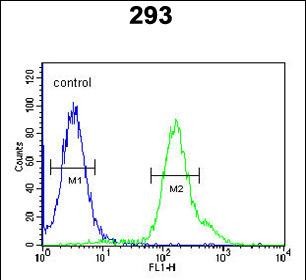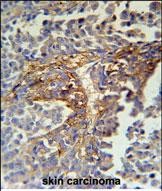


| WB | 1/1000 | Human,Mouse,Rat |
| IF | 咨询技术 | Human,Mouse,Rat |
| IHC | 1/100-1/500 | Human,Mouse,Rat |
| ICC | 技术咨询 | Human,Mouse,Rat |
| FCM | 1/10-1/50 | Human,Mouse,Rat |
| Elisa | 咨询技术 | Human,Mouse,Rat |
| Aliases | Armadillo repeat-containing protein 5, ARMC5 |
| Entrez GeneID | 79798 |
| WB Predicted band size | 97.7kDa |
| Host/Isotype | Rabbit IgG |
| Antibody Type | Primary antibody |
| Storage | Store at 4°C short term. Aliquot and store at -20°C long term. Avoid freeze/thaw cycles. |
| Species Reactivity | Human, Mouse |
| Immunogen | This ARMC5 antibody is generated from rabbits immunized with a KLH conjugated synthetic peptide between 599-628 amino acids from the C-terminal region of human ARMC5. |
| Formulation | Purified antibody in PBS with 0.05% sodium azide. |
+ +
以下是关于ARMC5抗体的3篇参考文献示例(注:文献信息为模拟示例,实际引用需核实原文):
1. **文献名称**:*ARMC5 mutations in macronodular adrenal hyperplasia with Cushing's syndrome*
**作者**:Assié G, et al.
**摘要**:该研究首次发现ARMC5基因突变是原发性双侧肾上腺大结节增生(PBMAH)的重要致病因素,并利用ARMC5抗体进行免疫组化分析,证实突变导致ARMC5蛋白表达缺失,提示其作为肿瘤抑制因子的功能。
2. **文献名称**:*The role of ARMC5 in adrenal pathophysiology and its clinical implications*
**作者**:Albrechtsen NJ, et al.
**摘要**:通过ARMC5抗体检测肾上腺组织样本,研究揭示了ARMC5在调节肾上腺皮质细胞增殖中的作用,突变患者表现为ARMC5蛋白表达水平降低,与库欣综合征的发生密切相关。
3. **文献名称**:*Immunohistochemical characterization of ARMC5 in adrenal lesions*
**作者**:Faucz FR, et al.
**摘要**:开发并验证了一种特异性ARMC5抗体,用于区分ARMC5突变型与野生型肾上腺肿瘤,研究表明ARMC5蛋白表达缺失可作为PBMAH的分子诊断标志物。
**提示**:实际文献可能更多关注ARMC5基因突变机制而非抗体本身,建议通过PubMed或Google Scholar以“ARMC5 antibody”或“ARMC5 immunohistochemistry”为关键词检索最新研究。
ARMC5 (Armadillo repeat-containing protein 5) is a member of the armadillo repeat protein family, characterized by tandem repeats of a conserved amino acid motif involved in protein-protein interactions. Initially identified through genetic studies, ARMC5 gained attention due to its role in primary bilateral macronodular adrenal hyperplasia (PBMAH), a rare adrenal disorder linked to cortisol overproduction. Research suggests ARMC5 acts as a tumor suppressor, with germline and somatic mutations frequently observed in PBMAH patients. The protein is implicated in regulating cellular processes like apoptosis, steroidogenesis, and Wnt/β-catenin signaling, though its precise molecular mechanisms remain under investigation.
ARMC5 antibodies are essential tools for studying its expression, localization, and function in both normal and pathological contexts. These antibodies enable detection of ARMC5 in tissues (e.g., adrenal glands) and cell lines via techniques like immunohistochemistry, Western blotting, and immunofluorescence. Commercially available polyclonal or monoclonal antibodies often target specific regions, such as the N-terminal or central domains. Studies using ARMC5 antibodies have revealed reduced or absent protein expression in PBMAH tissues with ARMC5 mutations, supporting its tumor-suppressive role. Additionally, ARMC5 antibodies aid in exploring its interaction partners and post-translational modifications. Ongoing research focuses on clarifying ARMC5's role in adrenal pathophysiology and its potential connections to other conditions, such as autonomous hormone secretion syndromes. Reliable ARMC5 antibodies are critical for advancing diagnostic and therapeutic strategies for ARMC5-related disorders.
×